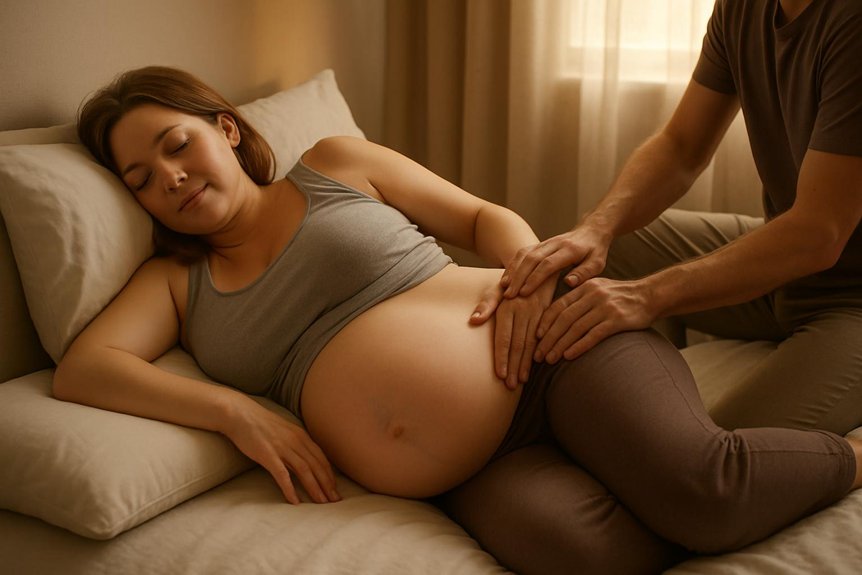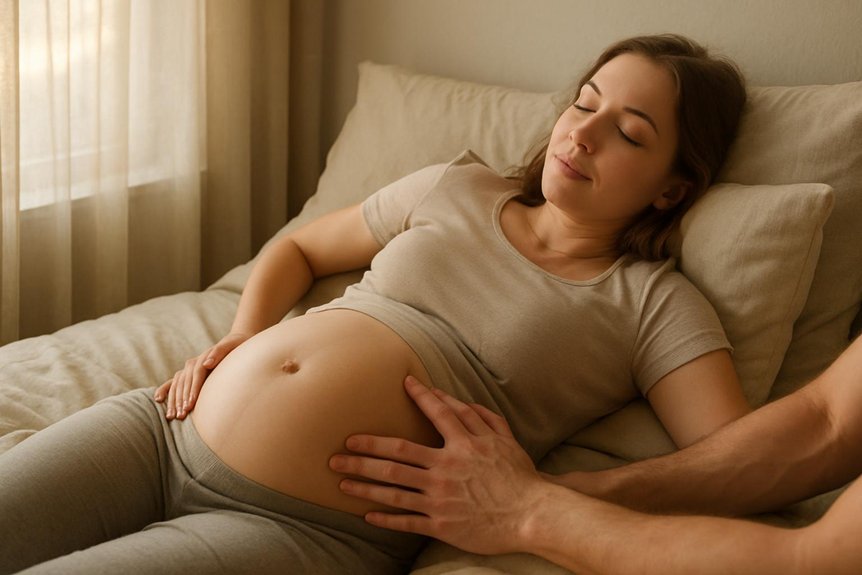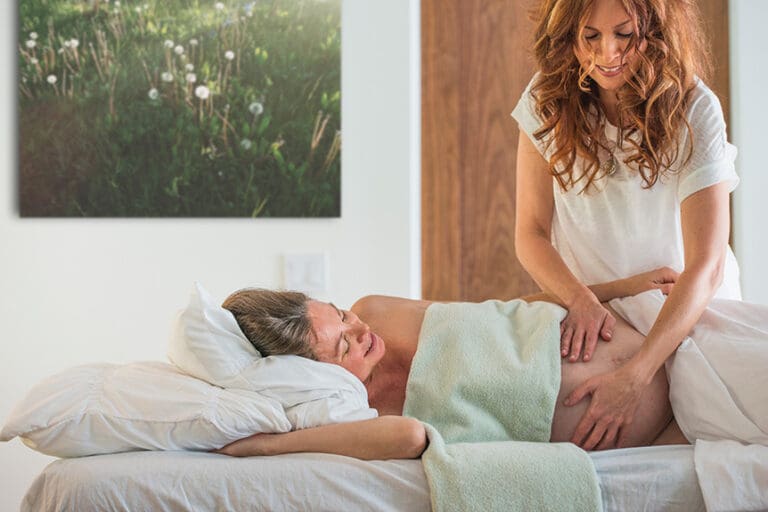Lower back massage is generally safe in pregnancy when modified for each trimester. Use gentle pressure early on, avoid abdominal pressure, and shift to side‑lying or semi‑reclined positions in the second and third trimesters with light to moderate pressure and shorter sessions. Self‑care can include light strokes, a tennis ball against a wall, warm (not hot) packs, and diaphragmatic breathing. Stop for pain, dizziness, or numbness. Seek care for red‑flag symptoms or persistent pain. More specifics can guide safe relief.
Is Lower Back Massage Safe During Each Trimester?

Lower back massage can be safe in pregnancy when adapted to each trimester and delivered by a trained therapist using pregnancy-specific positioning and techniques.
In the first trimester, gentle pressure with cautious pacing is recommended; sessions prioritise relaxation while avoiding abdominal pressure and overtly deep work.
In the second trimester, side-lying or semi-reclined positioning supports circulation and comfort; moderate pressure over paraspinal muscles is typically well tolerated when there are no red flags.
In the third trimester, shorter, more frequent sessions with careful bolstering and lighter-to-moderate pressure help manage lumbar strain and pelvic tension.
At Spa & Massage clinics in London, therapists screen for contraindications (e.g., preeclampsia, unexplained bleeding, severe swelling), coordinate with medical guidance when needed, and adjust techniques continuously, aiming for relief, safety, and tenderness.
Incorporating the soothing effects of aromatherapy massage can further promote relaxation and wellness during prenatal massages.
Techniques You Can Use at Home for Comfort and Safety
While professional care offers the most tailored support, several simple, low-risk strategies can ease pregnancy-related lower back discomfort at home.
Gentle self-massage with light, slow strokes along the paraspinal muscles—avoiding direct pressure on the spine—can reduce tension. Many clients at Spa & Massage find comfort using a soft tennis ball against a wall to release the glutes and sacrum, applying mild pressure for 20–30 seconds per point.
Side-lying positioning with pillows between knees and under the bump helps align the pelvis. Warmth (not hot) for 10–15 minutes can soothe spasms. Our therapists recommend unscented, pregnancy-safe oils in small amounts to reduce friction. Short sessions—5–10 minutes—paired with diaphragmatic breathing enhance relaxation.
If anything provokes dizziness, numbness, or increasing pain, pause and reassess technique.
When to Seek Professional Pregnancy Massage Support
Home strategies can provide meaningful relief, yet certain patterns indicate the need for professional assessment and care.
Worsening or persistent lower back pain beyond two weeks, pain that radiates to the legs, numbness, weakness, new swelling, fever, vaginal bleeding, reduced fetal movements, or a history of pregnancy complications warrants prompt evaluation and a tailored massage plan.
Acute injuries, falls, or pain affecting sleep or mobility also merit referral.
At Spa & Massage clinics in London, therapists trained in prenatal massage screen for red flags, liaise with medical providers when appropriate, and adapt pressure, pacing, and positioning to gestational stage.
They prioritise gentle, circulation‑supportive techniques to calm muscle guarding and pelvic strain.
Clients receive clear guidance on frequency, safe self‑care between sessions, and when to pause treatment and seek medical review.
Positions and Props That Protect You and Your Baby
A safe massage setup in pregnancy relies on positions and supports that keep the uterus off major blood vessels, protect the abdomen, and stabilise the pelvis. Evidence supports left side‑lying with the head, bump, and knees cushioned; this reduces aortocaval compression and allows precise lower‑back work.
Semi‑reclined positioning at 30–45 degrees can ease breathlessness while keeping pressure off the abdomen. Prone lying on standard tables is avoided; cut‑out tables may still strain ligaments.
At Spa & Massage, therapists use adjustable bolsters, wedge pillows, and towel rolls to align the spine, unload the sacroiliac joints, and soften paraspinal guarding. Neutral neck support, a pillow between the knees and ankles, and light abdominal draping maintain comfort and dignity, while enabling safe, focused relief.
Aftercare Tips to Reduce Pain and Support Recovery
Following a lower‑back prenatal massage, structured aftercare helps consolidate pain relief and minimise post‑treatment soreness. At Spa & Massage, therapists advise gentle hydration (a glass of water within an hour) to support circulation and reduce residual stiffness.
For 24 hours, they recommend avoiding heat extremes, vigorous exercise, and prolonged sitting; brief, frequent walks keep tissues supple. Side‑lying rest with a pillow between knees and a small cushion at the waist reduces lumbar load.
A warm (not hot) shower and light self‑stroking with unscented oil can soothe sensitivity; in our clinics, we use pregnancy‑safe blends and suggest patch‑tested oils at home. If tenderness arises, apply a cool compress for 10–15 minutes.
Monitor fetal movements as usual. Red flags—dizziness, cramps, fluid loss, or unusual back pain—warrant medical advice.
Conclusion
In closing, lower back massage can be safe and helpful throughout pregnancy when adapted by trimester, kept gentle, and guided by clear communication. One notable figure: up to 60–70% of pregnant people report low back pain, making targeted, cautious massage a meaningful tool. Using side-lying or supported seated positions, light-to-moderate pressure, and avoiding contraindicated areas helps protect parent and baby. When pain persists, professional prenatal massage—like that offered at Spa & Massage—provides evidence-informed techniques and structured aftercare to support recovery.



